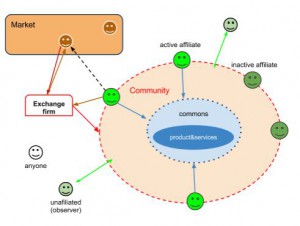
Open source hardware meets the p2p economy
We are at this moment in history when we can say with certainty that open source hardware (OSHW) is economically viable. The video below tells the success story of Adafruit Industries. Barely formed, this business model relying on OSHW might already be obsolete. A new model, the open value network, is already threatening to transform the landscape of the open source economy. This article explains why.
Most people find it counter-intuitive that companies can survive in a highly competitive capitalistic environment, designing and distributing high tech products, giving away their recipes, AND allowing (even encouraging) everyone else to copy them, WITH THE RIGHT TO MAKE COMMERCIAL USE.
If you don't believe it, stop wasting your time arguing against it. It is real, it is here, you better understand it fast before the world changes around you, leaving you an alien in your own surroundings.

The business around open innovation cannot be learned in school. It belongs to a new economic paradigm. Old arguments don't apply anymore, because the semantics and the logic are not the same. Some time ago, we published the article How to play the open game in the present and future economy, which tries to capture the essence of sustainable open innovation. You should revisit this article from time to time, becausewe'll continue to improve it.
GRAPHIC: The open value network is model for commons-based peer production. See SENSORICA as an example.
The most successful ventures build around OSHW, like Arduino, Adafruit, Sparkfun, etc., can only be understood within their larger ecosystem. We can identify two main structures: a commercial entity and a community. The commercial entity is a classical form, usually a corporation or a co-op. It takes care of manufacturing, insures quality, structures and integrates the feedback from the community into new products, nurtures the community, performs legal functions, integrates all the transactional logistics (storage, shipping, payment), and provides services. The community plays different roles: consumers of products, provide feedback on products, provide new designs, spread the buzz, educate new members of the community and provide help, etc.
Phi Beta Iota: Emphasis added.
See Also:



